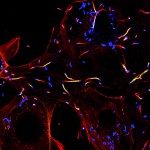Lien vers Pubmed [PMID] – 23532517
J. Leukoc. Biol. 2013 Oct;94(4):643-56
Neutrophils are notorious for their efficacy in microbial killing. Various mechanisms, such as phagocytosis, production of ROS, cytokines/chemokines and lipid mediators, degranulation of antimicrobials and enzymes, as well as NETosis contribute to this capacity. However, every incidence of neutrophil activation bears a risk to cause damage to the host. Several distinct steps, i.e., adhesion to endothelial cells, transmigration, chemotaxis, cytokine stimulation, and TLR signaling, are thought to control the extent of neutrophil activation. In the absence of a microbial stimulus, other pathways can induce neutrophil activation, among which FcR-induced activation when neutrophils encounter ICs. In these situations (inflammation, autoimmunity, allergy), neutrophils may act as primary or secondary effectors of immune reactions. In the presence of circulating ICs, neutrophils can indeed get stimulated directly in the bloodstream and trigger an immune response. Upon deposition of antibody complexes inside of tissues, neutrophils are first recruited and primed before being highly activated to amplify the ongoing inflammation. This review focuses on the engagement, activation, and responses of neutrophils to antibody ICs, inside of tissues or in the vasculature.


